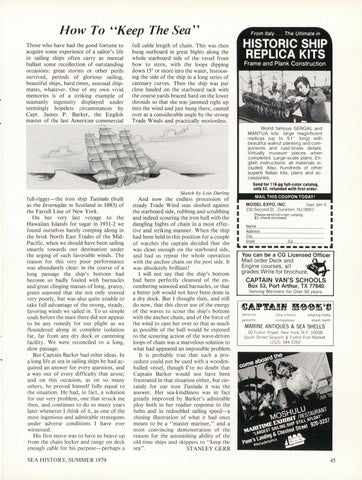How To "Keep The Sea" Those who have had the good fortune to acquire some experience of a sailor's life in sailing ships often carry as mental ballast some recollection of outstanding occasions: great storms or other perils survived, periods of glorious sailing, beautiful ships, hard times, unusual shipmates, whatever. One of my own vivid memories is of a striking example of seamanly ingenuity displayed under seemingly hopeless circumstances by Capt. James P. Barker, the English master of the last American commercial
full cable length of chain. This was then hung outboard in great bights along the whole starboard side of the vessel from bow to stern, with the loops dipping down 15' or more into the water, festooning the side of the ship in a long series of catenary curves. Then the ship was put close hauled on the starboard tack with the course yards braced hard on the lower shrouds so that she was jammed right up into the wind and just hung there, canted over at a considerable angle by the strong Trade Winds and practically motionless.
I'
World famous SERGAL and MANTUA kits : large magnificent replicas (up to 51 " long) with beautiful walnut planking and components and cast-brass detai ls. Virtually mu seum pieces when completed. Large-scale plan s. En glish in structions, all materials in c luded. Also , hundreds of other superb Italian kits, plans and accessories. Send for 116-pg full-color catalog, only $3, refunded with first order.
full-rigger-the iron ship Tusitala (built as the lnveruglas in Scotland in 1883) of the Farrell Line of New York. On her very last voyage to the Hawaiian Islands for sugar in 1931-2 we found ourselves barely creeping along in the brisk North East Trades of the MidPacific, when we should have been sailing smartly towards our destination under the urging of such favorable winds. The reason for this very poor performance was abundantly clear: in the course of a long passage the ship's bottom had become so badly fouled with barnacles and great clinging masses of long, grassy, green seaweed that she not only steered very poorly, but was also quite unable to take full advantage of the strong, steady, favoring winds we sailed in. To us simple souls before the mast there did not appear to be any remedy for our plight as we Ooundered along in complete isolation far, far from any dry dock or careening fac ility. We were reconciled to a long, slow passage. But Captain Barker had other ideas. In a long life at sea in sailing ships he had acquired an answer for every question, and a way out of every difficulty that arose; and on this occasion, as on so many others, he proved himself fully equal to the situation . He had, in fact, a solution for our very problem , one that struck me then, and continues to do so many years later whenever I think of it, as one of the most ingenious and admirable strategems under adverse conditions I have ever witnessed. His first move was to have us heave up from the chain locker and range o n deck enough cable for his purpose-perhaps a SEA HISTORY, SUMMER 1979
Sketch by Lois Darling And now the endless procession of steady Trade Wind seas sloshed against the starboard side, rubbing and scrubbing and indeed scouring the iron hull with the dangling bights of chain in a most effective and strik ing manner. When the ship had been held in this position for a couple of watches the captain decided that she was clean enough on the starboard side, and had us repeat the whole operation with the anchor chain on th e port side. It was absolute ly brilliant! I wi ll not say that the ship' s bottom had been perfectly cleansed of the encumbering seaweed and barnacles, or that a better job would not have been done in a dry dock. But I thought then, and still do now, that this clever use of the energy of the waves to sco ur the ship's bottom with the anchor chain, and of the force of the wind to cant her over so that as much as possible of the hull would be exposed to the scouring action of the wave-driven loops of chain was a marvelous solution to what had appeared an impossible problem. It is probably true that such a procedure could not be used with a woodenhulled vessel, though I've no doubt that Captain Barker would not have been frustrated in that situation either, but certain ly for our iron Tusitala it was the answer. Her sea-kindliness was in fact greatly improved by Barker's admirable ploy both in her readier response to the helm and in redoubled sailing speed-a shining illustration of what it had once meant to be a " master mariner," and a most convincing demonstration of the reason for the astonishing ability of the old-time ships and skippers to "keep the sea". STANLEY GERR
I I I I I I
MODEL EXPO, INC.
Dept S H- 5
I I I
230 Second St ., Dunellen , NJ 08812 Please send full-color catalog. $3. check enclosed.
I
Name Address Cit
I I
L--•-••••••••••.I You can be a CG Licensed ·Officer ~ · .. Mail order Deck and Engine courses, all . . grades. Write for brochure.
CAPTAIN VAN'S SCHOOLS Box 53, Port Arthur, TX 77640 Serving Mariners for Over 50 years.
lantern s
shi p wheels
sextants
compasses
whaling items sha rk teeth
MARINE ANTIQUES & SEA SHELLS 10 Fulton Str~et, New York . N.Y. 10038 South Street Seaport & Fulton Fish Market (2 12) 344·2262
45
